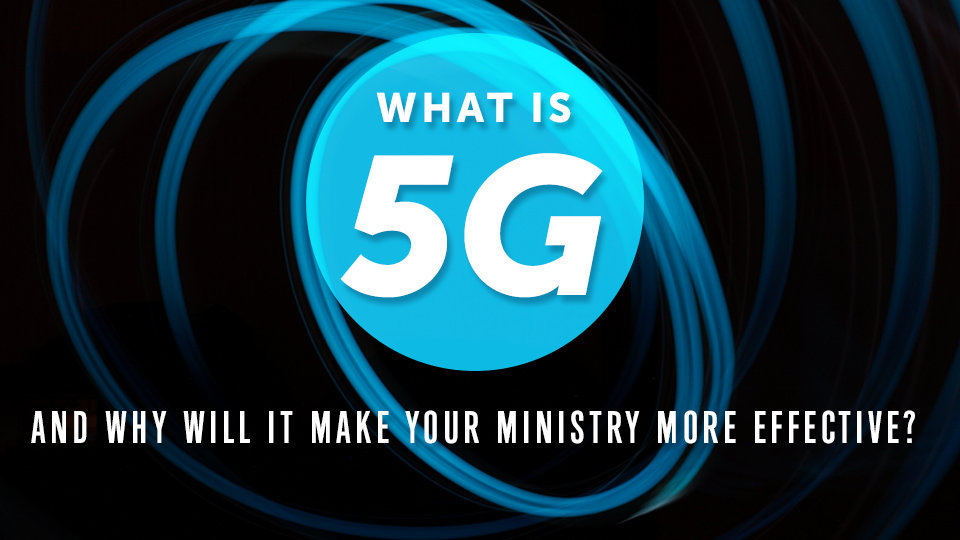What Is 5G and Why It Will Make Your Ministry Even More Effective
By Pete Wilson
If I had a dollar for every time one of my three boys complained about how slow our internet is at home, I’d be a rich man. But I guess they’re not alone. Everyone loves some lightning fast internet, so it’s probably no surprise that some really smart people backed by tons of money have been working crazy hard to make it even faster. And in order to pipe in enough bandwidth for that precious lightning-fast wireless feed, we’re going to need an entirely new form of wireless signal—that’s where 5G comes in.
So what is 5G? Let’s trace it back to its roots.
The “G” stands for “generation.” Wireless phone technology started with 1G, and in the early 1990’s it expanded to 2G when companies first started enabling people to send text messages between two cellular devices.
Then of course with the steady increase of cellular device usage, we moved on to 3G, which gave people the ability to make phone calls, send text messages, and browse the internet.
4G then enhanced many of the capabilities that had already been made possible with the third generation of wireless. People could browse the web, send text messages, and make phone calls—and they could even download and upload large video files without any issues.
Are you still with me? I’m almost through with the tech details, I promise.
So, about 5G. This is going to allow people to send texts, make calls, and browse the web as always—but it will dramatically increase the speed at which data is transferred across the network. 5G will make it easier for people to download and upload Ultra HD and 3D video. It will also make room for the thousands and thousands of internet-connected devices entering our everyday world.
Will it be that much faster? Oh yeah. For instance, right now it would take you about an hour to download a short HD movie on 4G LTE. With 5G, you’ll be able to download it in seconds.
When will it be available, you ask? Although both Verizon and AT&T, the nation’s two biggest Internet service providers, are already testing 5G in several states, most experts predict that 5G still won’t be widely available for a couple more years. Which means we have some time to wait, but we also have time to prepare.
Why is this important for your nonprofit or ministry?
Well at the very least, this serves as a reminder to us that mobile devices and the corresponding consumption of information via those devices impacts the way that we engage, market, and assimilate the people we’re trying to reach. Robert Wright, our Director of Technology here at The A Group, told me that “creating sites and applications that are mobile responsive is no longer just an option. It’s critical. What we see across the board, is that the vast majority of the audiences that visit the sites we build do so from a mobile device. Most of our sites probably average around 75%, while we have some sites where it’s as high as 90% of their visitors are accessing their site via a mobile device.”
If these stats bored you to tears, don’t fear. We listed out three things you should consider regarding communication via mobile devices with all those stats taken into consideration:
1. It’s where people are spending their time.
As you consider the journey your attenders, students, donors and target audiences take, mobile interaction is now an integral part of it—meaning that it’s now vital to include mobile.
Consumers are attached to their mobile devices. According to research from IDC, the typical consumer uses his/her device consistently throughout daily activities. In fact, 79% of smartphone users have their phone on, or near them, for all but two hours of their waking day. Four out of five smartphone users check their phones within the first 15 minutes of waking up. And get this! According to this same research, people spend an average of 195 minutes per day using their smartphone. We should be capitalizing on that.
2. Text communication is crazy effective.
Texting is a powerful way to get your message straight into people’s hands, without the clutter of email inboxes or noise of other channels. Text messages not only have at least a 90% average open rate, but they can also quite literally stop people in their tracks – an astounding 98% of people will read an SMS message within three minutes of that little beep, according to Nielsen Mobile studies. So if you’re not tapping into the power of SMS, now is the time to start.
3. Mobile-friendly sites rank higher.
Google now ranks mobile-optimized sites higher than non-optimized sites. This search giant officially acknowledges the importance of mobile in our lives – and made businesses, nonprofits and ministries stand up and listen. If your website doesn’t look, read and perform well on mobile devices, it will suffer in search results. It’s that simple.
Gartner, Inc. forecasts that 6.4 billion connected devices will be in use worldwide in 2016 (up 30 percent from 2015) and will reach 20.8 billion by 2020. That should be motivation enough right there!
If you’re reading all of this and realize that your web presence is not suited well for the rise of mobile demands, we would love to help you with that in any way possible. Our team at The A Group can help walk you through a strategic process to enhance your web presence so you’re able to keep up with the best of them.














